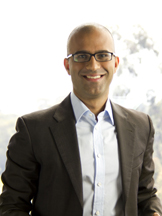
Dr. Mohit Kaushal
The move toward accountable care organizations, the ubiquity of cell phones and changing patient expectations all are contributing to the rise of mobile monitoring of chronic diseases, but it still may take years before home care becomes a routine part of medicine.
Friday morning at the 4th annual World Congress Leadership Summit on mHealth in Boston, Dr. Mohit Kaushal, executive VP of business development and chief strategy officer of the West Wireless Health Institute, La Jolla, Calif. surmised that it would take as many as five years to figure out effective business models for mobile monitoring.
In the meantime, organizations continue to experiment. "Technology is rarely a panacea," said Kaushal, former director of connected health at the Federal Communications Commission. However, it can be an impediment, since few monitoring devices or even text-based reminder systems connect to electronic health records.
"Data by itself is not valuable. It has to be integrated into the back end of EHRs," Kaushal said.
This is where process design comes into play.
Dr. David Judge, medical director of the Ambulatory Practice of the Future, a primary care clinic at Massachusetts General Hospital in Boston, noted that a lot of care in his practice takes place outside the physician office. He said there are still plenty of issues with integration and absorption of data.
"There are big barriers in engaging providers," Judge said. For one thing, physicians likely do not want to see financial data when making clinical decisions. "It can't all just flow to the doctor. How do you triage that?" he wondered.
He also said that the focus of monitoring needs to shift away from individuals. "What does it mean to take care of a population of patients?" Judge wondered during the panel discussion.
Care teams are getting smaller and smaller, according to Dr. Andy Steele, director of medical informatics at Denver Health, raising the imperative for patients to become more engaged.
Judge is not so sure physicians want to share EHR data. "Are we ready to show that to patients?" he asked.
It may not matter too much longer what healthcare professionals think about the idea, though. Consumers soon will expect access to their health information, according to Kaushal. "How come my bank can give me my information? How come I can make a [restaurant] reservation on Open Table? Why can't I get my information from you?" Kaushal asked.
"The patient needs to be the center of the hub of information," Judge insisted.
Patients, even those from low-income environments, appear to be ready.
"We had a lot of perceived barriers," Steele said. Denver Health, a safety net with about half of its patients lacking insurance and many of the rest on Medicaid, found that less than 5 percent of patients in a trial of home monitoring via cell phone had broadband Internet service at home. Yet, the program had 80 percent adoption even after six months.
"Don't underestimate what patients can do with technology," Steele reported, adding that about a third of mobile interaction with patients is not direct, but rather through a caregiver. For example, care managers at the health system frequently find themselves texting reminders to someone in Denver, who then gets on the phone to Mexico and tells a diabetic relative who had gotten care in Colorado to check his or her blood sugar, according to Steele.
"There is a tremendous variety in the way people use these devices," noted Jeff Bipes, senior manager of enterprise mobility design and strategy at medical device maker Medtronic. A wide choice of handsets, Bipes said, may be the reason why the Android platform leads the consumer smartphone market. The iPhone may be slick, but Apple follows the "Henry Ford model of smartphones," according to Bipes, where you can have any model you want as long as it's an iPhone.
















